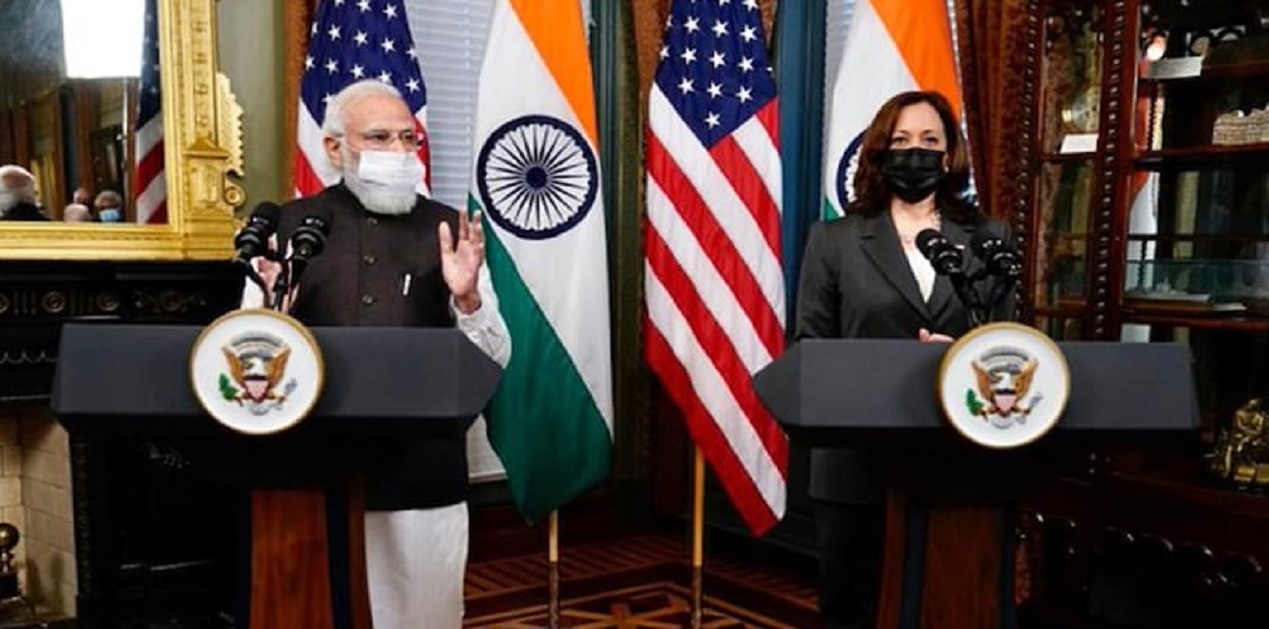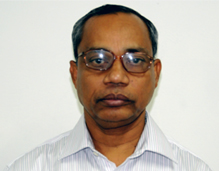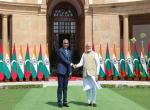From being what Dennis Kux, the US diplomat and author, called ‘estranged democracies’, India –U.S.A relationship has been transformed to ‘Comprehensive Global Strategic Partnership’. Prime Minister Narendra Modi’s current visit to USA is certainly going to scale up the relationship between the two countries. After the outbreak of COVID-19, it is for the second time that Prime Minister Modi is visiting a foreign country in person; earlier he visited Bangladesh to participate in the Independence Day of Bangladesh coinciding with the birth centenary of Mujibur Rahman. It may be noted that Prime Minister Modi thus has met three U.S. Presidents: President Barack Obama, President Donald Trump and now President Joe Biden suggesting the bipartisan support that India enjoys in the political spectrum of U.S. A.
It is an irony of history that the U.S.A and India-two of the world’s largest and vibrant democracies could not engage with each other in a meaningful manner in the post-war period. What prevented India from engaging with the U.S.A in spite shared values of democracy was India’s alignment with fight against imperialism, colonialism and identification with Afro-Asian nationalism during the time of cold war when the U.S.A was embroiled in the Korean Peninsula and Indo-China containing communism. While the USA looked at the cold war as a fight between democracy and communism, India looked at the decolonisation through the prism of Afro-Asian nationalism. What gave further twist to India’s foreign policy including its relationship with the U.S was India’s policy of Non-alignment distancing itself from the cold war. U.S.A regarded Non-alignment as ‘immoral’.
Pakistan’s joining of South East Asia Treaty organisation (SEATO) and Central Treaty Organisation, two of the security alliance outfits floated by the U.S.A during the cold war on the one hand strengthened relationship between U.S.A and Pakistan and on the other, resulted in the estrangement between U.S.A and India.
China’s intervention in Tibet in late 1950s and the outbreak India-China border war in 1962 tilted India’s relations in favour of U.S.A. On 19 November, 1962, in the wake of the India-China border war, when the Chinese forces reached the frontiers of India’s border, Prime Minister Nehru wrote two letters in quick succession on the same day to President Kennedy requesting immediate despatch of a minimum of twelve squadrons of supersonic all-weather fighter aircrafts and setting up of radar communications to defend Indian cities and towns against anticipated attack by the Chinese air force.1 The U.S.A, the UK and the Commonwealth countries responded to Nehru’s request for military aid. U.S.A provided some ammunitions of Second World War; weapons like 4.2 mortars and 3.7 howitzers. It also supplied 0.3 Browning machine guns, which were subsequently replaced. In fact the origin of the Quad as a coalition of democracies can be traced back to this period when China attacked India in 1962 and the democratic countries came together in defence of India.
What interrupted the growing India-US relations in the early 1970s was the liberation struggle in the erstwhile East Pakistan and India’s support to it which led to the birth of Bangladesh in 1971. Late Prime Minister Indira Gandhi entered into a treaty of friendship and cooperation with the Soviet Union in 1971 prior to the outbreak of the war. When war broke out between India and Pakistan, the Soviet Union openly helped India. The U.S.A sent its Seventh Fleet to the Bay of Bengal apparently to restrain India whose army had already entered East Pakistan and was fighting the Pakistan army alongside the Mukti Bahini of the Bengalis. This soured the relationship between the two countries. Prime Minister Mrs Indira Gandhi visited U.S.A in July 1982 and held a meeting with President Ronald Reagan.
The formation of NDA government under the leadership of Atal Behari Vajpayee in 1999, gave a new direction to the bilateral relations between the two countries. What, however, put a temporary pause in the bilateral relations was India’s nuclear explosion in 1998 which evoked critical US reprisal urging President Bill Clinton to invoke the Glenn Amendment of the Arms Control Act which imposed extensive economic and military sanctions on both India and Pakistan. In a letter to President Bill Clinton which was published in New York Times, Prime Minister of India Atal Behari Vajpayee, explained the rationale for the underground nuclear test. He wrote, “We have an overt nuclear state on our border, a state which committed armed aggression against India in 1962. Although our relations with that country have improved in the last decade or so, an atmosphere of distrust persists mainly due to the unresolved border problem. To add to the distrust that country has materially helped another neighbour of ours to become a covert nuclear test.”2
The Kargil War of 1999 between India and Pakistan in which USA played a positive role in averting a major war gave an impetus to India’s relations with the U.S.A. Sincere and honest parleys between two sides led by the then Foreign Minister of India late Jaswant Singh and former US Deputy Secretary of State Strobe Talbott put the bilateral relations on a fast track. It was appropriately reflected in a brochure published by American Embassy in India, “After almost half a century of talking at each other, India and the US grew accustomed to talking to each other. As Talbot said, “We are getting better at each disagreeing without being disagreeable.” It was the longest spell of high-level of dialogue that the two countries had engaged in their history3.
The tilt in favour of India manifested when Bill Clinton visited India in 2000. The visit was the first by a United States’ since Jimmy Carter’s visit to India in 1978. History took its full circle when Prime Minister Atal Behari Vajpayee, while speaking to the Asia Society in New York during his visit to the USA in 2003, described the U.S.A as a ‘natural ally of India’, an adage which was accorded to erstwhile USSR during the hallowed time of the Non-alignment Movement. A milestone in the bilateral relations was the announcement of the ‘Next Steps in Strategic Partnership’ in January 2004. The high point of relationship between the two countries was Indo-US Nuclear Deal announced by President George Bush in July 2005. In 2008 the Deal called 123 Agreement was formally signed by both sides. Ever since then there is no looking back. In both India and the U.S.A, there is now bipartisan support to the strategic partnership between the two countries.
The former US Defence Secretary Ashton Carter played a very important role in giving a boost to the Defence Trade Technology Initiative (DTTI), started in 2012. A significant development in the defence and security cooperation between India and U.S.A was the fructification of the new Framework Agreement for the India-US defence relationship in June 2015. Giving a momentum to it, the two countries signed the Logistics Exchange Memorandum of Agreement (LEMOA) in August 2016. After twelve years of sustained negotiation, India and USA finalised the LEMOA. This is a modified version of the standard logistics cooperation agreement that the US military has with a number of counties. The agreement enables the naval ships and aircraft of both the countries to dock in each other’s bases for refuelling and similar other purposes.4
The renaming of the US Pacific Command as the Indo-Pacific Command on 1st June 2018 was yet another symbolic gesture by the U.S.A to engage India in the Asia-Pacific in the context of China’s assertive behaviour. In September 2018, the India-US defence relationship received a major boost during the first 2+2 Dialogue in New Delhi, where the “foundational” Communications Compatibility and Security Agreement (COMCASA) was signed. COMCASA enables Indian military to get a clear picture of the Indian Ocean region which is witnessing increasing Chinese footprints.
The second round of 2+2 Ministerial Dialogue was held in Washington on19th December 2019. During the meeting the two countries announced significant progress under the DTTI including the finalisation of Statement of Intent to co-develop several projects and welcomed the finalisation of the Standard Operating Procedure for setting forth implementation guidelines for projects under DTTI and the Industry-to-Industry Framework. Both sides also welcomed the signing of the Industrial Security Annex (INA) which is aimed at facilitating the exchange of sensitive military information.
The third edition of 2+2 Ministerial Dialogue took place on 27 October, 2020 in New Delhi amidst the standoff between the two armies in the India-China border. A major outcome of the Dialogue was the signing of the Basic Exchange and Cooperation Agreement (BECA). The two countries welcomed the enhanced maritime information sharing and maritime domain awareness between their Navies and reiterated their resolve to build upon existing defence information sharing at the joint service and service-to-service levels and explore potential new areas of mutually beneficial cooperation.
After Joe Biden’s election as the U.S President in January, there was some speculation with regard to the continuance of the strong strategic partnership between the two countries, but soon the leadership of both the countries engaged with each other removing doubts. Prime Minister Narendra Modi had a telephonic conversation with President Joe Biden in April in the wake of India’s devastation with the second wave of COVID-19. The two leaders also met earlier virtually on the occasion of the first ever Quad summit meeting on March 12 along with Japanese Prime Minister Yoshide Suga and Australian Prime Minister Scott Morrison. The summit meeting reiterated the imperatives of “open” and “free” Indo-Pacific, besides cooperation to fight the pandemic. China’s assertive behaviour in Hong Kong, Taiwan and also in India-China border presumably prompted President Joe Biden to call for the Quad summit expeditiously. It also reflects U.S.A’s continued commitment under Biden’s Presidency to India and the challenge that it faced from China.
The defence cooperation between the two countries has also continued under Biden Presidency. The U.S. State Department in May this year approved the sale of P-81 patrol aircraft and related equipment. In November 2019, the Defence Acquisition Council of the Ministry of Defence had approved the procurement of the long range maritime surveillance aircraft manufactured by Boing. Earlier this month the US Navy handed over the first two MH-60R Multi Role Helicopters to the Indian Navy to face security threats and strengthen homeland security.5
The visit of Prime Minister Modi to U.S.A and his meeting with President Joe Biden and Vice-President Kamla Harris will certainly further strengthen the ‘ComprehensiveStrategic Global Partnership ‘between the two countries.
Endnotes:
- Studies and Analyses, New Delhi, 2015,pp17-19, https://www.idsa.in/monograph/USFactorinSinoIndianRelations_rndas
- “Nuclear Anxiety, Indian’s letter to Clinton on the Nuclear Testing”, The New York Times. May 13, 1988,https://www.nytimes.com/1998/05/13/world/nuclear-anxiety-indian-s-letter-to-clinton-on-the-nuclear-testing.html
- “People, Progress, Partnership: The Transformation of U.S.-India Relations,” Public Affairs Section, Embassy of the United States of America, New Delhi.
- Rup Narayan Das, “The India-U.S. Defence Relationship Grows Amidst Rising Tensions with China,” China Brief, Vol.20: Issue,11, https://jamestown.org/program/the-india-u-s-defense-relationship-grows-amid-rising-tensions-with-china/
- Rup Narayan Das, “Why is Blinken Rushing to Delhi”, Rediffnews, July 26, 2021,https://www.rediff.com/news/column/rup-narayan-das-why-is-blinken-rushing-to-delhi/20210726.htm
(The paper is the author’s individual scholastic articulation. The author certifies that the article/paper is original in content, unpublished and it has not been submitted for publication/web upload elsewhere, and that the facts and figures quoted are duly referenced, as needed, and are believed to be correct). (The paper does not necessarily represent the organisational stance... More >>
Image Source: https://akm-img-a-in.tosshub.com/indiatoday/images/breaking_news/202109/E__pIgbUUAIs1Wl.jpg?cYZBHg6v8sf_1pKmFEn5HF7aMTs4HHBb&size=770:433











Post new comment